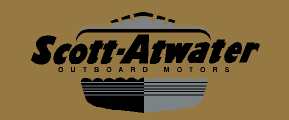Difference between revisions of "Scott Atwater"
(added history) |
(added 58 articles) |
||
| Line 134: | Line 134: | ||
File:Scottatwatera58002.jpg | 1958 Scott Atwater 40 HP Ad | File:Scottatwatera58002.jpg | 1958 Scott Atwater 40 HP Ad | ||
File:Scottatwatera58003.jpg |1958 Scott Atwater 60 HP Ad | File:Scottatwatera58003.jpg |1958 Scott Atwater 60 HP Ad | ||
| + | File:Scottatwatera58007.jpg |Flying Scott II article | ||
| + | File:Scottatwatera58006.jpg |Fashion Foundation award for outboard styling | ||
</gallery> | </gallery> | ||
Revision as of 01:21, 8 April 2015
History needed. Please contact us if you would like to edit this page.
Scott-Atwater Mfg. Co.
Minneapolis, Minnesota
Later purchased by McCulloch Corp. in 1956, this company began selling their own line of outboard motors in 1946. The founders previously manufactured outboard motors for Champion (Outboards) before forming the Scott-Atwater Mfg. Co. Firestone helped the newly organized firm get its start with a major contract to produce "Firestone" branded outboard motors for sale through Firestone dealers. Scott-Atwater brand outboard motors were sold through a separate dealer network.
The model introduced in 1946 was a 3.5 HP OBC Certified motor in standard and deluxe styles. Deluxe included an automatic recoil pull starter; standard was rope start. The following year a 7.5 HP model was added.
In 1948, the 3.5 HP was upgraded to 3.6 HP and a new "Speed Designation" was introduced. For instance the 3.6 HP model was also labeled the 1-12 because of its ability to idle down to speeds of 1 MPH or less and also achieve a top speed of 12 MPH on a small, lightly-loaded planing hull.
Scott-Atwater is notable because this company in 1949 first introduced outboard motors with forward, neutral, and reverse (F-N-R) gear shift. Prior to this innovation, operators had to start the motor in forward and swivel the outboard 180 degrees in order to reverse. F-N-R shifting was introduced simultaneously in three new models, the 4 HP 1-14, 5 HP 1-16 model, 7.5 HP 1-20 model. The non-shift 1948 3.6 and 7.5 HP motors were continued on in production, for a total of six models available in 1949.
Model Numbers
From 1946 to 1951, three-digit model numbers began with the model year (47, 48, etc.), and a number suffix corresponding to the motor style, roughly following this scheme:
0 - Standard Single (rope start)
1 - Deluxe Single (automatic recoil pull start)
3 - 7.5 HP Twin
6 - 30 HP Twin
7 - 5 HP Twin
8 - 10 HP Twin
9 - 16 HP Twin
An exception is 1946 in which "461" was a standard single, "467" a deluxe single. In 1949, the 48- models carried on with only the shift models receiving the "49" prefix. In 1950, the standard single "500" was a 3.6 HP 1-12 non-shift but now with a recoil starter; the 4 HP 1-14 F-N-R shift was the deluxe single for that year, "501".
From 1952 on, a four-digit model number was instituted. First number, "3" was for Scott-Atwater, "2" for Corsair. Second number was for motor size, using the above numbering scheme. The last two numbers referred to the model year in reverse, for instance "35" was 1953.
Scott-Atwater outboard motors were also sold by chain stores as Hiawatha (Gambles stores), Wizard (Western Auto stores, and Elgin (Sears, Roebuck & Co.). Both the Skelly Oil Company and the Pure Oil Company sold re-branded Scott-Atwater motors under the Corsair brand beginning in 1948.
1950 was the first year for the 16 HP 1-30 model which came with a separate fuel tank, also a first. In 1951, a 10 HP 1-25 model with integral fuel tank was introduced.
In 1953, Scott-Atwater introduced their "Gold Pennant" 7.5 and 10 HP outboard motors with twist-grip tiller throttle control as well as the previously introduced F-N-R gear shift. These motors had a stylish motor hood with gold coloring and separate 6-gallon fuel tanks. 1954 saw the introduction of the Bail-A-Matic, a bilge pump accessory attached to and operated by the outboard motor.
For the 1956 boat show circuit, Scott-Atwater commissioned Charles Clarke to design a series of seven concept outboard motors. Existing only on paper, these motors exhibited unique forms of propulsion and power sources including sound waves, hydrogen, solar energy, radial, and turboprop engines (Aug. 20, 1956 Sports Illustrated; Feb 3, 1956 Chicago Tribune). Sports Illustrated asked Brooks Stevens to design a equally innovative line of outboard motors and all the concept motors were shown together in a 1956 Sports Illustrated article (Aug. 20, 1956 Sports Illustrated).
For 1957, Raymond Loewy designed motor covers for the range of Scott-Atwater models. For the 40 HP model, motor covers were available in a range of colors.
Service Information
Information by Year
1949 Information:
1952 Information:
1953 Information:
1954 Information:
1956 Info:
1957 Information
1958 Information:
1960 Brochure:
1960 Guide to Scott Outboards
1960 Scott Dealer Display
1960 Distributor Packet
1961 Information:





































































